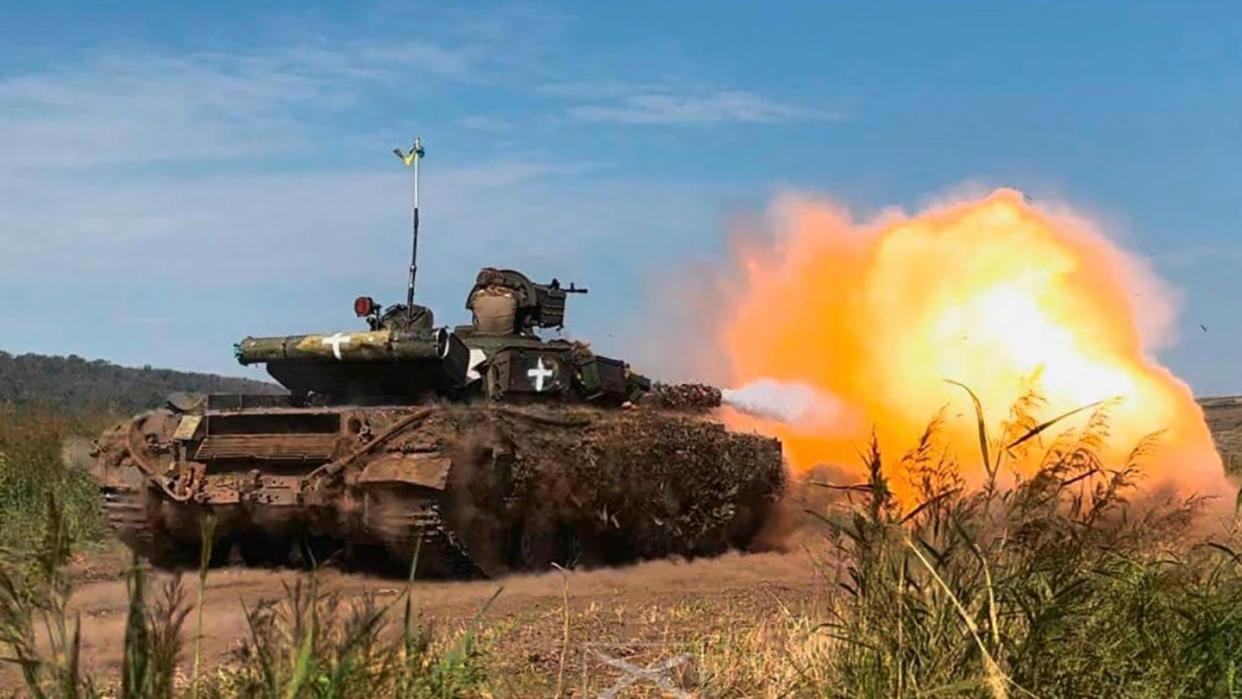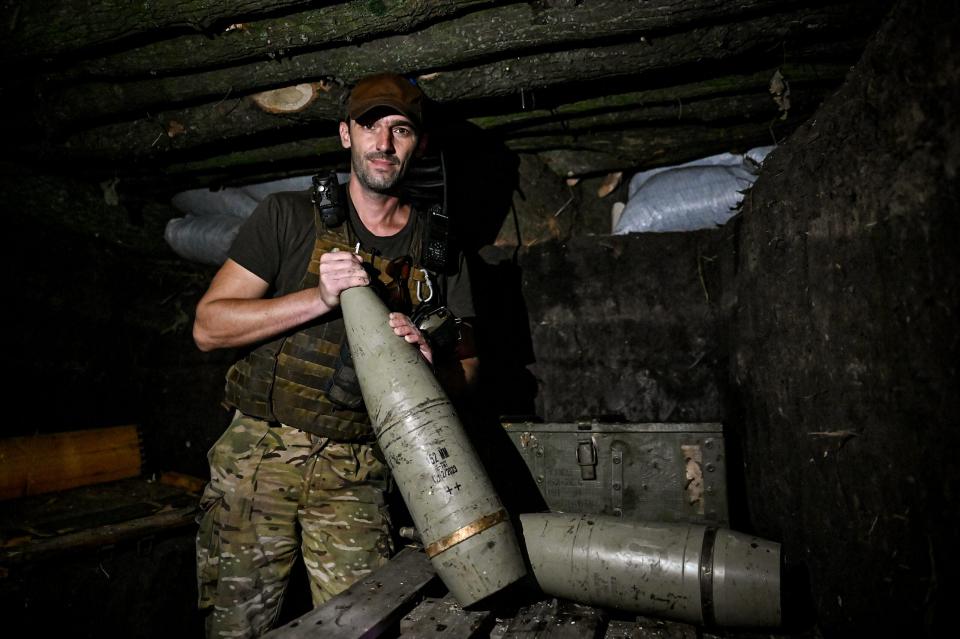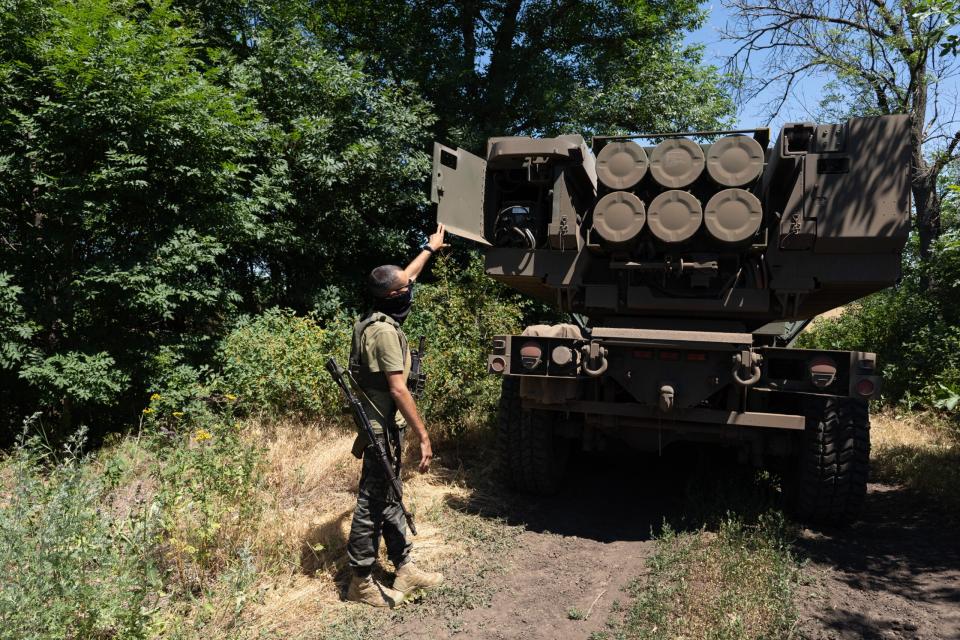Ukraine Situation Report: Breakthrough At Russia's Second Defensive Line

Ukraine continues to expand the salient it has created in Zaporizhzhia Oblast, pushing closer toward the small town of Verbove, the Institute for the Study of War says in its latest assessment.
“Geolocated footage posted Sept. 7 shows that Ukrainian forces have advanced northwest of Verbove and appear to be expanding their salient to the north of the settlement,” ISW reported.
https://twitter.com/TheStudyofWar/status/1699808003061338578
The movement more than three months into the counteroffensive is significant in that it shows Ukrainian troops have crossed at least the first of three Russian defensive lines and are at or near the second line.
"The Ukrainians are gradually gaining ground and it proves the importance of our support and also our ability and willingness to continue the support, because this is heavy fighting, difficult fighting, but they have been able to breach the defensive lines of the Russian forces and they are moving forward," NATO Secretary General Jens Stoltenberg said Thursday.
https://youtu.be/2Jy11bVdo2c
Though the counteroffensive’s progress has been heavily criticized in the West and even noted by Ukrainian officials, the ISW assessment also lines up with a more optimistic view painted recently by a U.S. intelligence official.
In a rare on-the-record statement, a U.S. Defense Intelligence Agency (DIA) official says Ukraine’s “breakthrough on that second defensive belt” near Robotyne in Zaporizhzhia Oblast “is actually pretty considerable.”
“Had we had this conversation two weeks ago, I would have been slightly more pessimistic,” Trent Maul, the DIA’s director of analysis, told The Economist in an exclusive story published Wednesday.
As The Economist explains, Maul’s agency is tasked with trying to answer questions like: Can Ukraine breach the second defensive line and the third one behind it before artillery ammunition becomes harder to find and winter weather sets in making any progress more difficult?
https://twitter.com/TheEconomist/status/1699760991762792808
To answer that, the DIA will look for signs that Russia can keep providing its front-line units with artillery and maintain leadership at the unit level.
Past analyses, he admitted, have not been spot on.
Maul conceded that American and Ukrainian officials failed to appreciate the depth of Russia’s defenses and how difficult it would be for Ukraine to “smash through” them with armor. Despite a report by the Guardian newspaper that 80% of Russia’s effort went into building its first and second lines, Maul warned that the bulk of Russia’s reinforcements remain at the third.
The DIA will also be monitoring Ukraine’s ammunition stockpiles as well as the weather, which will become wetter in the autumn, adding thick, oozing mud to any maneuver calculus.

Maul offered The Economist a less gloomy take on Ukraine’s chances of success than some unnamed Biden administration officials, one of whom estimated that Ukraine has about six to seven weeks of combat left before its counteroffensive culminates.
Ukraine’s recent successes are “significant” and give its forces a “realistic possibility” of breaking the remaining Russian lines by the end of the year, the publication reported, adding that Maul’s comment was “intel-speak for 40-50% probability.
Still, Maul did offer a caveat.
Limited ammunition and worsening weather will make this “very difficult.”
For its part, the Russian Defense Ministry hasn't outright denied that Ukraine has advanced to its defensive lines. Instead, it claimed on its Telegram channel Thursday that "units of the Russian grouping of troops, aviation and artillery, have repelled 14 [Armed Forces of Ukraine] attacks close to Verbove and Robotyne."
The coming weeks will show the level of progress Ukraine is really making in its drive toward cities like Tokmak and Melitopol as it seeks to either reach Crimea or cut off the so-called land bridge through Zaporizhzhia Oblast.
But as Maul, the DIA official told The Economist, attention is already turning to next year.
Even without a breakthrough this year, the DIA is moderately confident that if Ukraine can widen the salient around Robotyne, hold its positions and keep ammo flowing in, it will be well placed for a fresh push in 2024, he said.
Before we head into the latest news from Ukraine, The War Zone readers can catch up on our previous rolling coverage here.
The Latest
The Pentagon is pushing back on Russian complaints that depleted uranium (DU) tank rounds being given to Ukraine for use in soon-to-arrive Abrams main battle tanks pose grave health risks.
In response to the announcement yesterday that the U.S. was providing an unspecified number of these rounds, Kremlin spokesman Dmitri Peskov on Thursday said they increase cancer rates in areas they’ve been used in the past.
Hours later, Sabrina Singh, Deputy Pentagon spokesperson, countered that assertion, saying several studies have indicated that there are no health concerns from the armor-piercing rounds. A by-product of fuel produced for nuclear reactors that has greatly reduced radioactivity, DU is an incredibly dense metal. DU munitions on impact become a semi-molten projectile that burn through armor, with any fragments (also known as spall) that break off inside causing extreme damage to the interior and its occupants.
The video below offers a general overview of how the dart-like armor-piercing fin-stabilized discarding sabot (APFSDS) round, works.
https://youtu.be/coWJDfcdR60?t=99
And, while Singh said the Pentagon hopes those rounds will arrive in Ukraine at about the same time the promised Abrams tanks, similar DU munitions have already been promised by the U.K. for use in the Challenger 2 tanks it donated to Ukraine. You can read more about those rounds and how they work in our story here.
The DU rounds were included in one of two tranches of aid to Ukraine the Pentagon has announced over the past two days.
On Thursday the DoD announced an aid package, valued up to $600 million, through the Ukraine Security Assistance Initiative (USAI) that contracts out for items as opposed to taking them out of existing U.S. stocks.
The capabilities in the package include:
Equipment to sustain and integrate Ukraine's air defense systems;
Additional ammunition for High Mobility Artillery Rocket Systems (HIMARS);
105mm artillery rounds;
Electronic warfare and counter-electronic warfare equipment;
Demolition munitions for obstacle clearing;
Mine clearing equipment; and
Support and equipment for training, maintenance, and sustainment activities.

Singh declined to offer any details about what kinds of electronic warfare and counter-electronic warfare equipment that package will include.
That package follows one announced Wednesday, valued at up to $175 million, which included the DU rounds. That items will be delivered via the 46th Presidential Drawdown Authority package, which provides items from existing stocks.
In addition to the DU rounds, the capabilities in this package include:
Equipment to support Ukraine's air defense systems;
Additional ammunition for High Mobility Artillery Rocket Systems (HIMARS);
155mm and 105mm artillery rounds;
81mm mortars systems and rounds;
Tube-Launched, Optically-Tracked, Wire-Guided (TOW) missiles;
Javelin and AT-4 anti-armor systems;
Over 3 million rounds of small arms ammunition;
Tactical air navigation systems;
Tactical secure communications systems and support equipment;
Demolitions munitions for obstacle clearing; and
Spare parts, maintenance, and other field equipment.

Speaking of Javelins, Poland may one day produce the weapons locally under newly signed contracts.
According to Defense News, “Poland’s state-run defense group PGZ has signed a memorandum of understanding with the Javelin Joint Venture (JJV), a partnership between Lockheed Martin and RTX, formerly known as Raytheon Technologies, to jointly produce Javelin anti-tank weapons.”
“Together with PGZ, we are exploring a number of opportunities to leverage the resident skills and expertise of Polish industry for Javelin co-production,” Andy Amaro, the president of the JJV and RTX’s Javelin program director, was quoted in a statement.
The team-up with U.S. industry players will allow the partners “to evaluate the possibility to set up a final assembly plant and produce components in Poland,” PGZ said in its statement, the publication reported.
In addition, JJV representatives submitted an offer to the Polish group to have parts of Javelin weapons produced at PGZ’s subsidiary Mesko, according to the statement.
https://twitter.com/defense_news/status/1699707399601283145?s=20
A drone attack caused an explosion near Russia’s military headquarters in the city of Rostov-on-Don on Thursday.
Social media videos geolocated by CNN showed the attack in the vicinity of the military base. In a Telegram post earlier, Rostov regional governor Vasily Golubev said one person was injured and several cars were damaged after Russian air defenses intercepted two drones over the city.
An “emergency mode” was enacted around the crash site and 99 residents were offered alternative temporary accommodation, Golubev said, adding that no one was killed in the incident.
"Facades were damaged and windows of three buildings were broken, several cars were damaged. Only one person sought medical help, with incised leg wounds, he refused hospitalization," Golubev claimed.
Ukrainian officials did not make any immediate comment.
Rostov-on-Don is in southern Russia, not far from the Ukrainian border. It was briefly occupied by Wagner troops during the private military group’s brief rebellion against the Kremlin earlier this year.
https://twitter.com/kromark/status/1699662392848699825 https://twitter.com/igorsushko/status/1699618900873511282
There was also an unconfirmed Ukrainian drone attack on a major Russian microelectronics plant in Bryansk Oblast.
"A powerful explosion rocked Kremny El plant in Bryansk (western Russia), Russian media reported," according to the Ukrainian Euromaidan Press media outlet.
The governor of the Bryansk region, Aleksander Bogomaz, confirmed on his Telegram channel that there was an attack on an industrial facility there.
A Ukrainian drone attack "was made on an industrial facility in the city of Bryansk," he wrote. "As a result, the administrative building caught fire. There were no casualties. Fire brigades, operational and emergency services are on the scene."
Bogomaz did not specify which facility was hit.
Kremny EL is "the second largest producer of microelectronics in the Russian federation," according to the Ukrainian Defense Express media outlet.
https://twitter.com/EuromaidanPress/status/1699878863109607822?ref_src=twsrc%5Etfw%7Ctwcamp%5Etweetembed%7Ctwterm%5E1699878863109607822%7Ctwgr%5Ebccbbd95314b3a48d77acf26599505dafc1bc5e7%7Ctwcon%5Es1_\u0026ref_url=https%3A%2F%2Feuromaidanpress.com%2F2023%2F09%2F07%2Fkamikaze-drones-attack-microelectronics-plant-in-russias-bryansk-video%2F
A Ukrainian plan to attack the Russian fleet in Crimea last year with “submarine drones” was foiled not by the Russians, but by billionaire Elon Musk’s decision to turn off his company’s Starlink satellite communications network, a new book says according to CNN.
The news outlet published an excerpt adapted from Walter Isaacson’s new biography of the eccentric billionaire titled “Elon Musk.” It said the SpaceX owner issued a secret order to his engineers to turn off the network near the Crimean coast to disrupt the attack.
Musk did so concerned that a “mini-Pearl Harbor” as he put it would cause the Russians to respond with nuclear weapons. It was a fear, Isaacson wrote in his book, that was driven home by Musk’s conversations with senior Russian officials.
As a result of Musk’s move, Ukrainian submarine drones strapped with explosives approached the Russian fleet “lost connectivity and washed ashore harmlessly,” Isaacson wrote.
While the CNN article does not offer a specific timeline, Isaacson’s account lines up with our reporting from Sept. 21, 2022 about a mysterious drone boat, likely laden with explosives, washed up on the shore near Sevastopol, home of the Russian Black Sea fleet.
https://twitter.com/UKikaski/status/1572617974586183680?ref_src=twsrc%5Etfw%7Ctwcamp%5Etweetembed%7Ctwterm%5E1572617974586183680%7Ctwgr%5E8dbc9bbf47d2fabbb3f85bdc36a78dd4b61e86bb%7Ctwcon%5Es1_\u0026ref_url=https%3A%2F%2Fwww.thedrive.com%2Fthe-war-zone%2Fmystery-drone-boat-washes-up-near-home-of-russias-black-sea-fleet
A little more than a month later, Ukraine launched the first of an escalating series of uncrewed surface vessel (USV) attacks on Crimea. They were followed by USV attacks on Russian ships in the Black Sea and in July on the Kerch Bridge. None of those, obviously, sparked a Russian nuclear response.
https://twitter.com/GloOouD/status/1680832544827138048?ref_src=twsrc%5Etfw%7Ctwcamp%5Etweetembed%7Ctwterm%5E1680832616864399367%7Ctwgr%5Ec3a78dbcfdf99c77b9d4c32a7991d58a80c63aeb%7Ctwcon%5Es2_\u0026ref_url=https%3A%2F%2Fwww.thedrive.com%2Fthe-war-zone%2Fdrone-boats-used-in-kerch-bridge-strike-reports
Musk’s involvement with Ukraine stemmed from apparent humanitarian interests, providing the besieged nation with millions of dollars in his company’s satellite terminals. That allowed Ukraine to stay connected as it continued to fight despite Russian efforts to degrade cellular and internet communications.
But once Ukraine began to use Starlink terminals for offensive attacks against Russia, Musk started to second-guess that decision, according to the CNN book excerpt.
“How am I in this war?” Musk asked Isaacson. “Starlink was not meant to be involved in wars. It was so people can watch Netflix and chill and get online for school and do good peaceful things, not drone strikes.”
“Musk was soon on the phone with President Joe Biden’s national security adviser, Jake Sullivan, the chairman of the joint chiefs, Gen. Mark Milley, and the Russian ambassador to the US to address anxieties from Washington, DC, to Moscow, writes Isaacson,” according to CNN.
In June, Starlink signed a contract with the Pentagon to provide service to Ukraine, but no details on the price have been released.
“As you know, satellite communication is an important aspect of the fight that's occurring in Ukraine right now and we are working with Starlink and others of course on that front, but I'm not going to be able to provide any details,” Air Force Brig. Gen. Pat Ryder, the Pentagon’s top spokesman, told reporters at an Aug. 22 press conference.
https://twitter.com/CNNSotu/status/1699739634362618347
Russian drones attacked Ukraine’s Danube River port city of Izmail and elsewhere in the area for the fourth time in five days Thursday, Oleh Kiper chief of the Odesa region military administration, said on his Telegram channel.
The attack injured one person and damaged port and grain infrastructure, he said. A day earlier, he described a strike that killed one person and also destroyed port and grain infrastructure.
These ports have become even more critical as Russia issued a de-facto blockade on shipping in the Black Sea.
https://twitter.com/michaelh992/status/1699696250264715567
Meanwhile, after vigorous denials, Romanian authorities on Wednesday acknowledged that they may have found debris from a Russian drone in their territory, which is less than a half-mile across the Danube. The finding did not sit well with Romania’s president. That's even though he was one of those who brushed off the initial claims - made by a Ukrainian official as well as open-source investigators - that a Russian drone had crossed into and landed on a NATO member’s territory.
“If it is confirmed that these elements come from a Russian drone, such a situation would be completely unacceptable and a serious violation of the sovereignty and territorial integrity of Romania, a NATO allied state,” Romanian President Klaus Iohannis said Wednesday on his Facebook page. “As I said before, these attacks on Ukrainian civil infrastructure, which are war crimes, take place at a very short distance from the Romanian border. However, we are alert and in permanent contact with the other NATO allies.”
Romanian Defense Minister Angel Tîlvăr on Wednesday confirmed that Russian drone wreckage may have been found in his country and said "that additional measures will be taken to strengthen the monitoring and security capabilities of Romania's airspace at its borders,” according to the Romanian MoD.
https://twitter.com/AJEnglish/status/1699539312218341722
On Thursday, Stoltenberg said it does not appear that Russia is deliberately trying to attack Romania.
"We don't have any information indicating an intentional attack by Russia, and we are awaiting the outcome of the ongoing investigation," NATO Secretary-General Jens Stoltenberg told EU lawmakers, according to Reuters.
Stoltenberg stressed the risks Russian air strikes in such close vicinity to the alliance's territory posed.
https://twitter.com/EuromaidanPress/status/1699766969640042926
Beyond the death and destruction and continuing loss of badly needed grain in these attacks, the visit by Romanian officials to a suspected Russian drone crash site on Wednesday shows an increasing level of concern by a NATO ally over these attacks.
Russia began hitting Ukraine’s Danube River ports on July 24, with an attack on Reni. That came after Moscow's withdrawal last week from the Black Sea Grain Initiative. That followed a suspected July 17 Ukrainian uncrewed surface vessel (USV) attack on the Kerch Bridge, though Russia claims no link.
https://twitter.com/revishvilig/status/1680806685848268800?ref_src=twsrc%5Etfw%7Ctwcamp%5Etweetembed%7Ctwterm%5E1680806685848268800%7Ctwgr%5Ef593e52a510a05b86641767789a577f29aa0c227%7Ctwcon%5Es1_\u0026ref_url=https%3A%2F%2Fwww.thedrive.com%2Fthe-war-zone%2Frussias-kerch-strait-bridge-closed-after-major-incident
Two days ago, we told you about the press conference former Russian Mi-8AMTSh Hip combat transport helicopter pilot Maxim Kuzminov held to discuss his Aug. 9 defection, with the aircraft, to Ukraine. Today, an image emerged on social media of two key players in front of that aircraft: Ukrainian President Volodymyr Zelensky (left) and Maj. Gen. Kyrylo Budanov, head of the Defense Intelligence Directorate (GUR) whose agency engineered the defection.
https://twitter.com/saintjavelin/status/1699812829493149857?s=20
Russia's efforts in Ukraine may be having an effect not just there and at home, but also on Moscow's in Armenia, across the Caspian Sea.
Russian officials are “alarmed” at plans between Armenia and the U.S. to hold military exercises starting next week. Armenian officials yesterday announced the exercise it says are “aimed at preparing units for international peacekeeping operations,” according to The Associated Press.
“As regards the exercise, certainly, the news raises alarm, especially in today’s circumstances,” Kremlin spokesman Dmitry Peskov said after the announcement.
Armenia has long-standing ties with both the U.S. and Russia. However, Armenia has become increasingly disillusioned with Russia since the 2020 war with Azerbaijan and again after the September 2022 conflict between those two nations. That's when the Russian-led Collective Security Treaty Organization (CSTO) refused to intervene or even criticize Azerbaijani troops' incursion into Armenian territory in September 2022.
https://twitter.com/visegrad24/status/1699528911158231383?s=20
The first reported recording of the use of a Ukrainian-developed Kombat anti-tank guided missile used in a T-64BM2 tank is seen in this video below being placed into the barrel by the tank's autoloader.
https://twitter.com/front_ukrainian/status/1699828694099918861
An image of a Ukrainian-made UJ-23 Topaz jet-powered drone emerged on social media Wednesday. The Topaz is made by UKRJET, which also makes the UJ-22, a propeller-driven drone that looks a bit like a Cessna, one of which was found, with explosives, on the ground a short distance from Moscow in April.
According to UKRJET, the Topaz "is a multi-purpose unmanned aircraft system with jet UAV that is able to be used at any time of day and season, in visual and adverse weather conditions and under electronic countermeasures."
The company's specification say it has a cruising speed of 600 km/hour, a maximum speed of 800 km/hour a controlled flight radius of 100 kilometers and can reach a maximum altitude of six kilometers.
It is unclear if the Topaz has gone into production or is being fielded yet, and what its true capabilities are. Clearly reduced radar cross-section was an intended feature, as well. We reached out to the company for more details.
https://twitter.com/clashreport/status/1699398651401953296?s=20
The Russian ZSU Hunter 2.0 Telegram channel on Wednesday posted images and video it says show the wreckages of U.K.-donated Storm Shadow air-launched cruise missiles and U.S.-donated AGM-88 High-speed Anti-Radiation Missiles, or HARMs.
"In the Zaporizhzhia direction, the Russian Armed Forces regularly intercept or shoot down expensive Storm Shadow cruise missiles and AGM-88 HARM anti-radar missiles," ZSU Hunter 2.0 claimed Wednesday.
https://twitter.com/clashreport/status/1699417989676728649
Russians have routinely claimed without proof to have constantly downed these weapons. However, images of the remains of Storm Shadow and HARM missiles recovered by Russia have emerged on social media.
Back in July we reported that Russia did recover at least one Storm Shadow that was in a partially intact state. It was unknown if the missile was shot down or malfunctioned, but it appeared to be the first public documentation of the weapon since they hit the battlefield in May. You can read more about that in our story here.
In August of 2022, images emerged on social media showing what appeared to be a portion of the rear body and a tail fin from an AGM-88 missile, which were said to have been recovered after they hit a house in Ukraine's southeastern Kherson region. As with the Storm Shadow, it was unclear if the HARM was shot down or malfunctioned. It was one of two HARMs recovered in the span of a few days. You can read more about that in our story here.
https://twitter.com/UAWeapons/status/1557764847697383431?ref_src=twsrc%5Etfw%7Ctwcamp%5Etweetembed%7Ctwterm%5E1557764847697383431%7Ctwgr%5Ee4303890e1ba601d0d1767b3f21dd870450c328d%7Ctwcon%5Es1_\u0026ref_url=https%3A%2F%2Fwww.thedrive.com%2Fthe-war-zone%2Fnew-evidence-of-agm-88-anti-radiation-missile-use-by-ukraine-emerge
So much of what's taking place in the war is encapsulated in the video below of a Ukrainian strike on a Russian ammunition delivery in progress.
The video shows a strike by a Guided Multiple Launch Rocket Systems (GMLRS) munitions fired by the M142 High Mobility Artillery Rocket Systems, or HIMARS and the M270 Multiple Launch Rocket System (MLRS). It's reported to take place on Russian troops transporting 9M127 Vikhr laser-guided anti-tank missiles, which are used on Ka-52 Alligator helicopters that are playing a role in defending against the ongoing counteroffensive, which you can read more about here. And it captures troops going about their business in the moments before they are , the kind of vivid detail that has been a hallmark of this conflict.
https://twitter.com/clashreport/status/1699460839562989628?s=20
Ukraine has brought a lot of innovation to the battlefield during this conflict, but not everything it has tried has worked, as this video below highlights.
An apparent effort to create a DIY multiple launch rocket system is seen failing in spectacular fashion. A rocket fails to launch and the thrust from the exhaust pushes the vehicle still attached to to it forward until it topples over. We don't know if there was anyone hurt.
https://twitter.com/front_ukrainian/status/1699459793985888578?s=20
And finally, even before Russia launched its full-on invasion of Ukraine, the commander of that nation's Defense Intelligence Directorate (GUR) has managed to irk officials in Moscow. On Thursday, the Day of Military Intelligence in Ukraine, Maj. Gen. Kyrylo Budanov took his trolling to a new level.
https://twitter.com/gerashchenko_en/status/1699803189950939363?s=12\u0026t=BQRSNakUKt7_8ssZiGBW-A
That's it for now. We'll update this story when there's more news to report about Ukraine.
Contact the author: howard@thewarzone.com

